Lot 98
Northwest Corner of Churton and Tryon Streets
Town Cemetery
c. 1754
The first use of this lot was for a town burial ground. In March 1767, the church wardens of St. Matthew's Parish sued Gerald (or Gerard) Prestwood of New Hope for breach of promise for failing to build a fence around the cemetery. The fence was needed to prevent livestock from wandering into the graveyard as the commons was adjacent to this lot. The wardens won their suit, recovered £1.11.3 in damages, and £2.5.11 in court costs and by 1768, a fence had been built. Tradition maintains that the earliest graves were for people who had been born in the 1600s in Great Britain. Nearly all of the graves on lot 98 have been lost.

The 1768 Sauthier map depicts lot 98 containing a fenced-in cemetery and eleven graves.
No church is yet located on the lot but space has been allocated for one.
St. Matthew's Church
c. 1769
A lost deed dated March 8, 1757, indicates that William Churton granted this lot to Church Wardens for the establishment of an Episcopal church and an Act of Assembly of 1766 formally confirmed the designation. Accordingly, historians believe that St. Matthew's Episcopal Church was constructed between 1766-1769 under the supervision of Rev. George Micklejohn. Micklejohn had been born in England and was ordained in 1764. He was appointed to the Orange County Parish by Governor William Tryon. Sometime prior to 1786, he married Elizabeth Lockhart, the daughter of Samuel and Catherine Lockhart, a prominent family of Orange County.
The church was most likely designed by architect, contractor and accountant John Hawks. Hawks arrived in North Carolina with Tryon in 1764, and was, according to Tryon, “a very able Worthy Man.” Tryon had hired Hawkes to build Tryon Palace in New Bern as well as other public buildings to improve the stature and trade of the colony.
As the largest meeting space in Orange County, St. Matthew's was used as a public gathering place in addition to a house of worship. From August 20 to September 10, 1775, after British Governor Josiah Martin disbanded the North Carolina House of Burgesses and fled the colony, the Third Provincial Congress was held in St. Matthew's. This congress, which included representatives of all 35 counties and nine towns, officially established itself as the highest governmental body in the province. The North Carolina Legislature continued to meet here in 1778, 1782 and 1783. During this time of war, the building was also used as a hospital.
Unfortunately, St. Matthew's suffered damage from its use as a meeting place and hospital. In 1783, the Methodist itinerant preacher Francis Asbury noted that, “It was once an elegant building, and still makes a good appearance at a distance, but within it is in ruins.”

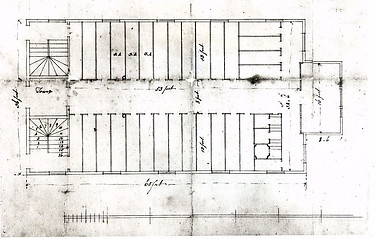

(L. and C.) Exterior and interior sketches of St. Matthew's Church
The exterior drawing indicates that the church had a clock in its steeple. However, no corroborative evidence exists. Local lore maintains that the clock was a gift to the town from George III and that in 1771, the clock was removed from the church tower when Loyalist David Fanning raided the town of Hillsborough. This story cannot be proven and seems highly unlikely
(R.) February 1768 Advertisement in Rind's Virginia Gazette looking for a builder for a church in Hillsborough
Hillsborough Academy
1784
Hillsborough Academy was established in 1779 by an act of the State Legislature which declared, “Whereas, the proper Education of Youth in this State is highly necessary and would answer the most valuable and beneficial purposes to this State, and the good people thereof; and, Whereas, the Neighbourhood of Hillsborough from the Healthiness of its Situation, and the great plenty of provisions with which it abounds, is a fit and proper place to erect a Seminary.” The first trustees were William Hooper, Alexander Martin, John Kinchen, Thomas Burke, Thomas Hart, Nathaniel Rochester, James Hogg, William Johnston, and the Rev. James Frazier.
In 1784, the trustees of the Hillsborough Academy employed Martin Palmer as the general contractor to convert the old St. Matthews Church into a boys’ academy building. A legislative act of 1784 noted that the church was “already far gone to decay” and authorized a lottery to raise “not more than £500” to pay for the work, hire tutors, etc."
To transform the church into a schoolhouse, the workmen removed the ecclesiastical features. Cabinetmaker George Hoskins made new windows and a man named Minckley supplied shingles, “For covering the church after taking down the steeple.” Palmer replaced the flooring and, among other tasks, either patched or replaced the leaking roof. He was paid £120 for his carpentry work.
Because Hillsborough was the largest town in the most centrally located spot in the state of North Carolina, and the Hillsborough Academy building was still the largest meeting space, from July 21 to August 4, 1788, delegates met there to determine whether to ratify the Constitution. The debate resulted in the delegates voting 184 to 84 to neither ratify nor reject the Constitution. One of the major reasons for North Carolina not ratifying the Constitution was its lack of a Bill of Rights.

An artist's rendition of how the building looked at the time of the Constitutional ratification conference.
By the end of the century, the building had once again fallen into disrepair. In 1797, an act of Assembly authorized the Sheriff to sell the building that was, “In a ruinous and decayed situation, and has not been for a number of years past occupied as a place of divine worship.”
Sometime shortly afterward, the building was either destroyed in a fire or sold for "parts."
Hillsborough Presbyterian Church
1814
In 1810, the Town Commissioners of Hillsborough petitioned the General Assembly for aid in building a church. In response, the Assembly passed an act to raise a lottery or lotteries to raise a sum, not to exceed five thousand dollars, for the purpose of building a church. Whether a lottery was held is unknown but a large number of townspeople purchased subscriptions to allow the construction to go forward.
A simple 33’x50’ brick church was built on or near the spot where the old one had been. Instead of a tower or steeple, it had a hip roof. The interior had no paneling or any sort of decoration and was heated by a stove located in the rear, right-hand side.
The construction began in 1814 and was completed in 1816. Samuel Hancock is credited with the work. Hancock was the mentor of local brick-mason and builder John Berry who was eighteen at the time at likely helped with the building project.
After the sanctuary was completed, the State made it available to the first religious body in town to call a minister. Rev. John Knox Witherspoon accepted the call, granting the property to the Presbyterian Church, which had been organized by the Orange Presbytery that same year.
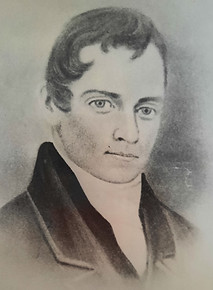
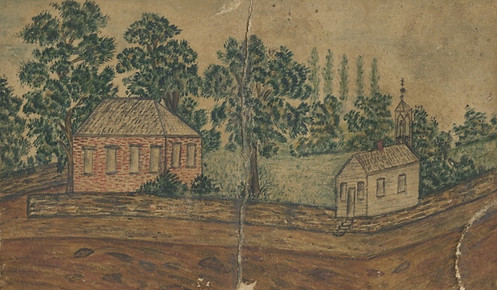

(L) A Drawing of Rev. John Knox Witherspoon. He was known for his elegance, mild manners, and sweet, musically-toned voice, and for being a tireless comforter to the sick, aged, and unfortunate.
(C) An 1838 drawing of the Presbyterian Church and Session House by Louisa Taylor.
Taylor married William Clark and moved to New Bern.
(R) A recording of the total amount raised for Rev. Witherspoon's salary in 1825. An accompanying note lists the donors and the amounts that they contributed, ranging from $1 from Margaret Wall and a few others to $60 from James Webb and William Norwood.
The drawing and the accounting are in the collection of the Orange County Historical Museum.
In 1892, the exterior was covered with stucco and pointed-arch Gothic windows, a gabled roof, and a shingled entrance tower with steeple were added. Additionally, the two-story, side-gabled rear wing was most likely added at this time. In 1948, a large, one-story educational wing was added to the north side.
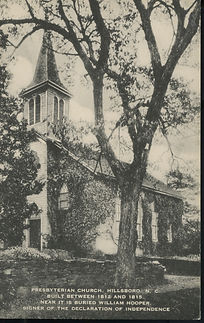

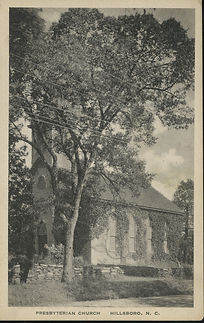
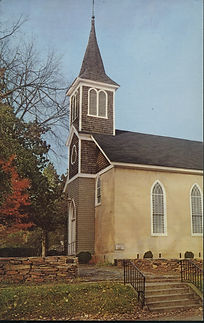
Various Postcards of the Hillsborough Presbyterian Church from circa 1900 to 1969
Session House
1836
In 1836, the Presbyterian Church built a Session House for use as a Sunday school and meeting room. The Town of Hillsborough leased the property to the church for 99 years at $1.00 a year. The building was frame and clapboard and included a tower on its northern end.

C. 1900 Postcard of the Hillsborough Presbyterian Church and Session House, looking East
Public Library
1910
In 1910, the Session House was loaned to the newly formed local library association and converted into the town library. The north tower was removed, while a shed porch and door were added to the west side.


Confederate Memorial Library
1934
In 1934, the Session House building was torn down and a new stone building was constructed to house the library. It was built as a United States Federal Civil Works Administration (CWA)/Federal Emergency Relief Administration (ERA)/North Carolina Emergency Relief Administration (NCERA) project. Much of the $15,466.10 cost was contributed by the Daughters of Confederate Veterans who donated money in lieu of erecting a memorial obelisk. Consequently, the building was called the Confederate Memorial Library.


(L.) The Confederate Memorial Library shortly after of opening and
(R.) c. 1955
.png)
(R.) Hattie Dunn Williams served as the county librarian for many years
Orange County Historical Museum
1983
The idea for the creation of a historical museum in Orange County was formed when artifacts were displayed in the Courthouse during the 1952 Bicentennial celebrations of the founding of the county. The project was championed by the Hillsborough Garden Club. Under the leadership of Mrs. Clarence Jones, members of the Garden Club worked tirelessly to find financial support, a location, and volunteers to run the Museum. With the assistance of the NC Department of Archives and History, the Old Courthouse was determined to be the best site for the Museum and a collection was established by soliciting donations from local.. In 1980, the county decided to renovate the Old Courthouse and reclaim the courtroom. The Museum was evicted. Following protests and lawsuits, the Museum moved to its current location on lot 98.



(l) The Orange County Historical Museum c. 2017, after removing the title "Confederate Memorial Library" from its entryway
(r) 2017 Executive Director Candace Midgett leads students on a tour of the Museum
The Hillsborough Historical Society was founded in 1962 by a group of interested citizens. Among their many activities, they filed applications for buildings to be included in the National Register of Historic Places, gave historic walking tours, and published newsletters and journals.
In May 2007, the Orange County Historical Museum merged with the Hillsborough Historical Society to form the Historical Foundation of Hillsborough and Orange County.


1998 photographs of exhibits and events at the Orange County Historical Museum.


